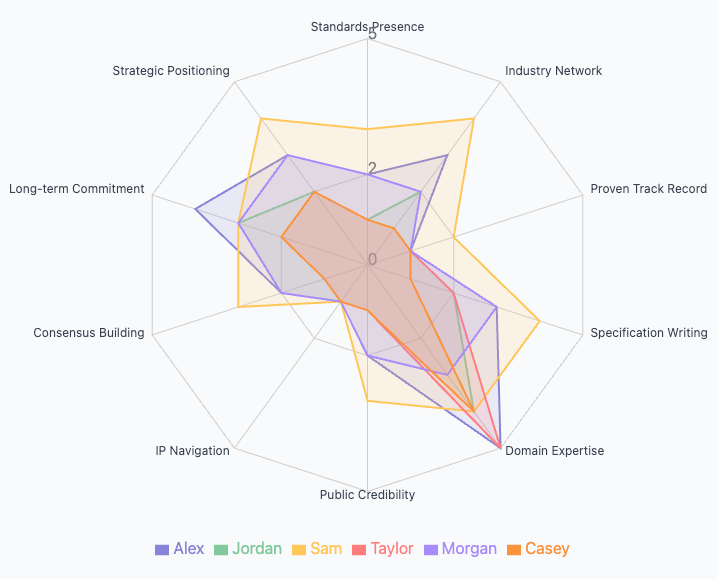Most teams engineer products better than they engineer teams
Your team lacks diversity because you lack a vision
I was reading Anton’s post, “Build your engineering team like a dungeon party” and it reminded me of the time a senior leader completely grilled me.
I was in a group meeting and this leader, with thousands of people reporting to them, asked me question after question about the people on my team. They wanted to know every little detail about each person. Their strengths, hobbies, passions, and weaknesses. They actually cared.
It was surreal.
I later followed up with them to understand why they cared so much. Their answer shaped how I think about building winning teams. About how I approach diversity.
Over the years, I built a four-step process to team composition. I’d love to share it with you.
Yep, that’s me. You’re probably wondering how I got here.
in medias res. That’s Latin for in the middle of things.
You start at the end, then begin your journey. It makes for interesting movies and stories. It’s also a wonderful leadership tool.
Before you figure out what your ideal team composition should be, start with what your team will accomplish.. Not what it needs to, not what it should, but what it will achieve. You can call it a vision statement if you want.
Examples:
In three years, we handle Black Friday traffic every single day.
In three years, our platform handles 100x current traffic with the same team size.
In three years, our API is the industry standard that every competitor integrates with.
That’s the first step.
Invent an enticing future.
A “Big Hairy Audacious Goal.”
(A BHAG, pronounced “Bee Hag.”)
Yep, that’s you.
Now wonder how you got there.
Outputs
Let’s take ‘making our API the industry standard’ as an example.
How do you get there? What needs to happen for this to be true?
In this example, these can be:
1k+ developers use implementations of our standard.
A member of our team is on the relevant standards committee.
Two major companies publicly commit to implementing this standard.
A major standards body (W3C, IETF, etc.) adopts our API specification.
Three competitors integrate with our standard instead of building a competing API.
Inputs
Now, let’s continue. What needs to be true about our team for us to achieve these outcomes? What behaviors, skills, knowledge, or connections do we need to have?
For our example:
Standards Presence - Active participation in relevant standards body working groups (attending 80%+ of meetings)
Industry Network - Existing relationships with decision-makers at 5+ major tech companies in the space
Proven Track Record - Successfully shepherding at least one technical proposal through a standards process
Specification Writing - Ability to write technical specifications that pass standards body review on first or second iteration
Domain Expertise - Deep expertise in the specific protocol/API domain being standardized
Public Credibility - Speaking/publishing presence in the technical community (3+ conference talks or papers per year)
IP Navigation - Understanding of IP/patent implications and ability to navigate legal considerations in standards
Consensus Building - Skill at building consensus across organizations with competing interests
Long-term Commitment - Patience and willingness to work on 3-5 year timelines
Strategic Positioning - Strategic thinking to position the standard for broad adoption beyond just technical merit
This gives you a clear and specialized list of competencies that you need on your team. It is tailored exactly for achieving the BHAG that you set out to achieve.
Here and now
Finally, let’s get back to the present. You have an existing team, a group of humans.
Give every person a 1-5 rating on each dimension:
The purpose of this exercise is to identify big gaps in your ability to achieve the future that you invented. A great way to see these gaps is to use Radar Diagrams, which display the above table visually:
It’s now clear that your team is not very diverse. Not diverse in the ways that matter for your unique situation.
With it, you can:
Hire new people, starting with a very clear job description.
Get specialized training for people already on your team.
Partner with Subject Matter Experts (SMEs) in your company, such as Legal.
Tune growth plans. Match personal career aspirations with closing gaps, such as sending Sam to standards meetings.
Get a budget to hire consultants.
The Four Step Process
To recap:
Invent a compelling future.
Identify what needs to be true for this future to materialize.
List all the team competencies that you need to make these things true.
Assess your current team against these bespoke competencies, and plan how to close the gaps.
When that senior leader grilled me, this is what they were getting at. They wanted to understand how I built my team. What I was looking at. How close I was to the details.
Winning teams have both a big hairy audacious goal and dive into the details to make it happen.
To follow up on Anton’s Dungeons and Dragons inspired post, great leaders are like Gandalf. They figure out what they need to accomplish, then build a specialized team. A team where every person brings unique strengths that are necessary to make that impossible heist a success.
That’s what my Gandalf taught me. Now I’m passing it to you.






Just wanted to say that Gemini chose a really “interesting” representation for the team…
Thank you so much for sharing this, Gilad!
Reading it made me think about how much paying attention to both the bigger picture and the details matters.
I’m noticing how valuable it is to see strengths, connect skills to goals, and keep people at the heart of what we do.
Btw, the picture is so funny :)